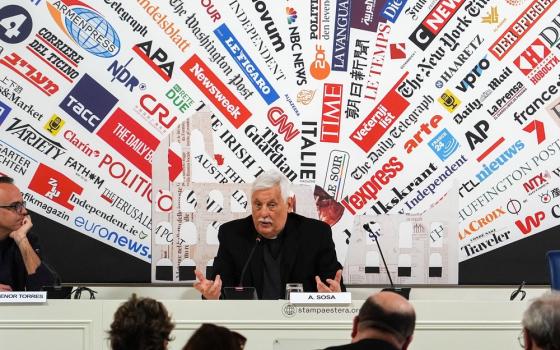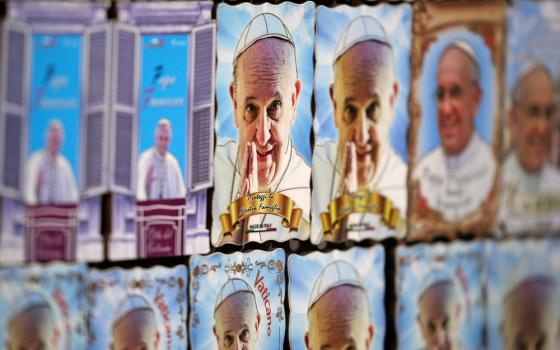
The Sistine Chapel at the Vatican (CNS/Paul Haring)
"God so loved the world that he gave his only son." Who is this God? One of the images of God that has most captured the Christian imagination comes from Michelangelo's depiction of the creation of Adam.
We see the almighty God, surrounded by angels, leaning out of heaven over Adam, finger almost touching finger — a picture of majesty and beauty. This Sistine Chapel image could hardly be more different from how the African-American poet James Weldon Johnson describes God in his poem "The Creation." We can almost hear Johnson's voice whispering in holy awe as he says, "This great God, like a mammy bending over her baby, kneeled down in the dust, toiling over a lump of clay … Then into it He blew the breath of life." This second image, God with an artisan's fingers and muddy knees, is certainly less well known and offers us a distinct perspective on today's Gospel.
| The Solemnity of the Most Holy Trinity |
| Exodus 34: 4b-6, 8-9 Daniel 3:52, 53, 54, 55, 56 2 Corinthians 13: 11-13 John 3: 16-18 |
So often we have heard John 3:16 proclaimed as a guilt-enhancing reminder that God sent Jesus to suffer for human sin, an image which depicts a god of wrath who placated his own anger through his son. That image is reinforced by the victorious Christ of the Sistine Chapel's "Last Judgement." There we see Jesus with arm upraised as the dead rise and the condemned plummet into the jaws of hell. Yet, everything changes if we hear this Gospel against the background of Johnson's portrayal of the tender mother leaning over and caressing her baby into being. This latter image is the God who knows how to stoop down, who reveals divine dignity as generosity, whose every breath is life-giving.
Today's Gospel tells us that God does three things: God loves the world, God gives the Son, and God sent the Son into the world. Just to be sure we make no mistake: The Gospel explains that God's purpose in sending the Son was not to condemn but to save.
God's love is no new revelation. Love is the theme that underlies all of the Hebrew as well as the Christian Scriptures. Our reading from Exodus reminds us that God's key self-revelation in ancient times began because God heard the cry of the people and sent Moses to lead them to freedom. In today's reading from Exodus 34, the God whose name is incomprehensible to the human mind and unpronounceable by the human tongue, stands and talks with Moses. God tells Moses that being God means loving with a motherly, generous mercy, exercising long-lasting patience, and demonstrating unshakeable fidelity.
That is like the image of God presented in Psalm 23, "The Lord is my shepherd." The God of Abraham and Moses is the God who continues to beckon humanity toward fullness of life. Then with the Incarnation, Christianity adds the unthinkable to that image. When today's Gospel says, "God so loved the world that he gave his only Son," we need to understand that with the backdrop of John 1:14, "The Word became flesh." That means that being our tender, creator-redeemer and shepherd was not enough. God's love is such that all of those roles or images were still too distant, too separate. The God whom Christians know entered into our very condition, not as an alien ambassador, caring but distinct, but as one of us. Christianity knows God not just as the Lord of history, but as Emmanuel, God in our history. John says that the Son became one of us so that everyone might have eternal life.
In his homily in Morelia, Mexico, Feb. 16, 2016, Pope Francis put simple human flesh on that idea when he said, "Jesus wished to introduce His companions into the … mystery of His life. He showed them by eating, sleeping, healing, preaching and praying, what it means to be Son of God. He invited them to share his life, his interiority." 
With those words, Pope Francis summed up this feast, the Solemnity of the Most Holy Trinity. Today we celebrate because the God we know, the God w hose self-revelation began from the moment of Creation and continues until now, is "God for us," ever desiring to be in closer, deeper, fuller union with humanity. God became flesh to share our life and to bring us to divine life. Jesus bequeathed the Spirit of his own interiority to attract us toward the community of love we call the Trinity. No image will ever be adequate to describe God, but God will always be near, luring us toward greater union through and with and in Christ.
[Mary M. McGlone, a Sister of St. Joseph of Carondelet, is currently writing the history of the Sisters of St. Joseph in the U.S.]



